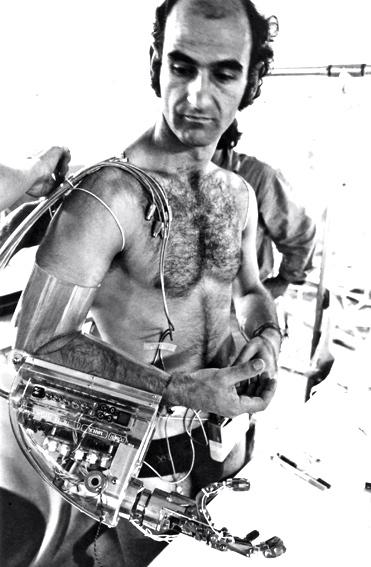Stelarc is a performance artist. His work involves prosthetics and he seeks to extend the human body and its capabilities.
Third Hand


Appearance
A mechanical human-like hand that is attached to my right arm as an additional hand. It is made to the dimensions of my real right hand.
Cosmetic Cover
Cast in latex from my right hand. It was thought necessary to protect the sensors and to provide adequate friction for gripping. It was never permanently worn over the mechanism because for performance purposes only the visual motion and operation was important.
Materials
Aluminium, stainless steel, acrylic, latex electronics, electrodes, cables and battery pack.
Capabilities
Pinch-release, grasp-release, 290 degrees wrist rotation (clockwise and counter-clockwise), and a tactile feedback system for a sense of touch.
Control System
The motions of the hand are controlled by the electrical signals of the muscles (EMG), typically from the abdominal and leg muscles for independent movements of the three hands. Simply, signals from muscle contractions are picked up, pre-amplified, rectified and sent to the switching system.
History
The hand was completed in 1980 in Yokohama. It was based on a prototype developed at Waseda University. It was constructed with the assistance of Imasen in Nagoya. It has been used in performances by the artist between 1980- 1998 in Japan, the USA, Europe and Australia. It has become the best- known and longest-used performance object for the artist. Originally it was designed as a semi- permanent attachment to the body, but because of skin irritation from electrode gel and the weight of the hand, support structure and the battery pack (approx. 2 kgms), it could not be worn continuously and thus it became a special performance device. The Third Hand has come to stand for a body of work that explored intimate interface of technology and prosthetic augmentation- not as a replacement but rather as an addition to the body. A prosthesis not as a sign of lack, but rather a symptom of excess. The Third Hand performances, with amplified body signals and sounds, have contributed to cyborg discourses on the body, included in more recent performances such as FRACTAL FLESH, PING BODY and PARASITE. See documentation of the performance postcards for a conceptual context.
(Taken from: http://stelarc.org/?catID=20265)
Third Ear

I have always been intrigued about engineering a soft prosthesis using my own skin, as a permanent modification of the body architecture. The assumption being that if the body was altered it might mean adjusting its awareness.
(Taken from: http://stelarc.org/?catID=20242) (Photograph: Portrait of Stelarc’s 3rd Ear by Shaun Gladwell, London 2014)












![Click to enlarge [Hythe sound mirror, May 2003]](https://i0.wp.com/www.andrewgrantham.co.uk/images/mirror/hythe1.jpg)








